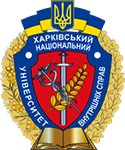Cyberterrorism: content, forms and promising countermeasures
Abstract
The purpose of the study is to clarify the concept of cyber terrorism, its typical features and main forms, and to develop proposals for improving the system of countermeasures. The article highlights modern approaches to defining the content of cyber terrorism and its social and legal nature. This type of terrorism should be regarded as a socially dangerous politically motivated activity aimed at disrupting the critical information infrastructure of the State and thus creating a danger to human life and health or causing other serious consequences, provided that such actions were committed for terrorist purposes, or using cyberspace for other purposes of terrorist activities not directly related to terrorist acts.
Typical features of cyber terrorism are described and a definition of its concept is proposed. The main forms of cyber terrorism are revealed: the commission of terrorist acts by organisations, groups and individuals using computers and computer networks or by influencing the information processed (circulated) in them, as well as the use of cyberspace for other purposes of terrorist activities not directly related to the commission of terrorist acts.
The counteraction system may be based on the following: proper regulation of the concept of cyber terrorism in national legislation, criminalisation of acts of cyber terrorism and its components; enhancing the security and protection of critical information infrastructure; improving existing and applying new counteraction methods; improving cooperation in the field of combating cyber terrorism.
Downloads
References
Beliakov, K. I., & Tsymbaliuk, V. S. (2003). Information technologies as factor of assassination. Combating Organized Crime and Corruption (Theory and Practice), 8, 90–97.
Mynyn, T. (2005). Seven steps to khalyfat. “2000”. A3.
Dubov, D. V. (2014). Cyberspace as new measuring of geopolitical rivalry. NISD.
Baranetsky, V. (2009, November 5). What is cyberterrorism? Even experts can’t agree. Harvard Law Record. https://web.archive.org/web/20091112093639/http://www.hlrecord.org/news/what-is-cyberterrorism-even-experts-can-t-agree-1.861186.
Collin, B. (1997). The Future of Cyberterrorism. Crime & Justice International Journal, 13, 51–71.
Gable, K. A. (2021). Cyber-Apocalypse Now: Securing the Internet against Cyberterrorism and Using Universal Jurisdiction as a Deterrent. Vanderbilt Journal of Transnational Law, 43(1), 57–118.
Palyvoda, V. O. (2021). National strategy of counteraction to internal terrorism of the United States of America. Kyiv. https://niss.gov.ua/sites/default/files/2021-07/usa-national-strategy.pdf.
Anderson, K. (2010, October 13). Virtual Hostage: Cyberterrorism and politically motivated computer crime. The Prague Post. http://www.praguepost.com/opinion/5996-virtual-hostage.html.
Klymchyk, O. O., & Kravchenko, R. M. (2010). Criminal law qualification of the use of computer technologies for assassinating. Information Security of a Person, Society, State, 1(3), 26–30.
Butuzov, V. M. (2010). Counteraction to computer criminality in Ukraine (system structural analysis). KYT.
Melnyk, S. V., Tykhomyrov, O. O., & Lienkov, O. S. (2011). To the problem of formation of the conceptual and terminological apparatus of cyber security. Collection of Scientific Works of the Military Institute of Kyiv National Taras Shevchenko University, 30, 159–165.
Pylypchuk, V. H., & Dzoban, O. P. (2011). Theoretical and state law aspects of counteraction to informative terrorism in the conditions of globalization. Strategic Priorities, 4(21), 12–17.
Dovhan, O. D., & Khlan, V. H. (2011). Cyberterorism as a threat to informative sovereignty of the state. Information Security of a Person, Society, State, 3(7), 49–53.
Golubev, V. (2004). Electronic terrorism is a new face of terrorism. Computer Criminality and Cyberterrorism, 1, 49–56.
Hnatiuk, S. (2013). Cyberterrorism: history of development, modern tendencies and counter-measures. Information Security, 2(19), 118–129.
Tropina, T. L. (2004). Cybercrime and cyberterrorism. Computer Criminality and Cyberterrorism, 1, 76–81.
Bryzhko, V. M., & Shvets, M. Ya. (2007). Е-struggle in informative wars and informative right (M. Shvets, Ed.). NDTsPI APrN of Ukraine.
Ibrahimov, V. (2004) Cyberterorism in the Internet before and after September, 11, 2001: estimation of threats and suggestion on their neutralization. Computer Criminality and Cyberterrorism, 1, 56–75.
Hrebeniuk, M. V. (Ed.). (2019). Scientific and practical commentary on the Law of Ukraine “On the Basic Principles of Ensuring Cyber Security of Ukraine”. As of January 1, 2019. National Academy of the Prosecutor’s Office of Ukraine.
Reznikova, O. O., Misiura, A. O., & Voitovskyi, K. Ye. (2020). International terrorism: threats for Ukraine. Analytical message. Kyiv.
Golubev, V. A. (2004). Cyberterrorism is a threat of national safety and interests of Ukraine. Law Journal, 1, 132–134.
Butuzov, V. M., & Titunina, K. V. (2007). Modern threats: computer terrorism. Combating Organized Crime and Corruption (Theory and Practice), 17, 316–324.
Melnyk, D. S. (2018, March 30). Regarding the urgent needs of protecting the national critical information infrastructure of Ukraine [Conference presentation abstract]. IX All-Ukrainian Scientific and Practical Conference “Actual problems of state information security management”, Kyiv, Ukraine.
Copyright (c) 2023 D. S. Melnyk

This work is licensed under a Creative Commons Attribution 4.0 International License.



